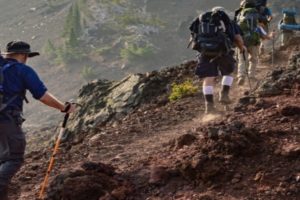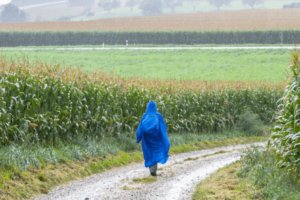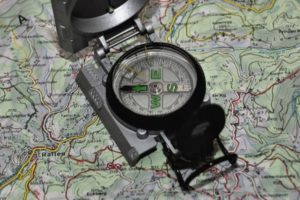
Hiking boots are the most essential piece of equipment for any hiker. At their worst they can be the difference between finishing a hike or ending it early due to blisters, and even injury. At their best they can provide you with the grip and comfort needed to tackle even the most challenging of terrain. The difference between a good pair of boots and bad pair of boots is the difference between having a good day on the mountains and having a nightmare. Choosing the right set of boots will help your hiking, but more importantly save you feet from getting blistered.
Before we start looking at any hiking boots, I would like to mention one point - Price is important with any hiking boots, however I would also remind you that you’re buying a pair of hiking boots to last you a good five years. It’s not un-common to see hikers walking around with boots that are 10 years old.
What Hiking Boots Should I Choose
The first thing to consider when purchasing hiking boots is what type of hiking boots will fulfil your specific needs. In general there are three types; hiking shoes, day hiking books and back packing boots.
- Hiking shoes are, as the name suggests, not boots, but shoes. The lightest option of the three, they are perfect if you are going short distances or wanting to travel a fast pace over mostly flat terrain. They are often the choice, for example, of ultra runners. They are perfect for day walkers who are looking for support and grip on the hills, but they're not great for the open countryside. They offer very little ankle support and even less waterproofing if you step into a boggy puddle. Yes you could combine with a decent set of gaiters, but it's recommend if you're walking in the open countryside, you look at the below two models.
- Day Hiking Boots - If you require more support, particularly round the ankle areas, you can choose from day hiking boots and Mountaineering Boots. The day hiking boots are the happy medium. They are flexible enough for quick day hikes and sturdy enough for slightly longer trips over medium to difficult terrain.
- Mountaineering Boots - For anything longer or more difficult, such as mountain terrain, you are advised to purchase Mountaineering Boots. In comparison to hiking boots, they extend above the ankle, giving you the cushioning and support you'll need for mountainous terrain or multiple day trips. The key downside of mountaineering boots, is there weight. The heavier the boot, the more work for your legs. An extra pound on your legs is equal to over 10 pounds on your shoulders.
Five Hiking Boot Features To Look Out For
Boot Weight – The weight of you boot is very important. The heavier your boots, the more your leg muscles are going to need to work to get you up the mountain. Look out for hiking boots that are made from lightweight materials such as gortex, Full-grain leather and Synthetics to include polyester, nylon and synthetic leather.
Waterproof – You need to buy a hiking boot that is totally waterproof for a few reasons. Firstly, if water gets inside your boot it will add the weight of your boot and you know the problems with this. Secondly wet boots cause terrible odors and are a direct contribution to blisters as they cause a friction build up between your socks and your feet. Look out for boots that are made from GoreTex membranes and synthetics.
Load Support – There are three parts of the hiking boot that you need to think about, the forward/backward motion, the left/right movement and the foot arch support. If you’re out camping, its likely you’re going to have a heavy backpack and this requires support to stop your feet moving to far forwards, backward, to the left or to the right. Supporting your foot arches is also important and stopping your feet flattening out to much under pressure will save a lot of foot pain.
Toe Bumper – The most common injury amongst hikers is twisted ankles and stubbed toes. Buying hiking boots with decent load support and properly tying your laces will help to prevent twisted ankles, whilst buying boots with a solid toe support will stop stubbed toes. I would highly recommend that you buy boots that have plastic toe support and not metal toe supports. If something heavy lands on your foot and bends the metal, it can be a very painful experience trying to get your foot out of your boot.
Gusseted Tongue – is the part of the boot that joins the two side your boot together. It’s important that you buy boots with a decent tongue as they stop small stones and water finding there way inside your boot. Generally there are two tongue designs, one that keeps the tongue separate from the boot and a second that is joined to the boot. It’s entirely your choice which model you choose, however if you’re buying a hiking boot with an all-in-one tongue design, you need to make sure you fold the material correctly when you’re tying your boots otherwise the extra material can cause problems.
Leather Vs Non Leather
The choice of whether you choose leather boots or non-leather boots is typically a personal choice. 20 years ago, you had a to buy hiking boots made from leather as there really were not alternatives. Today with developments across fabrics, there is a choice of materials, however typically they resolve around three key fabrics; leather including leather based fabrics such as Split-grain leather or Nubuck leather, Synthetics such as polyester, nylon and so-called "synthetic leather" and waterproof membranes such as Gore-Tex or eVent.
The general feeling when you compare leather and non-leather products is that fabric boots are lighter, more breathable and generally cheaper whereas leather boots are usually more durable and naturally more water resistant than suede or fabric.
Below are a few pointers to help you make a decision on which style you want.
Leather Walking Boots
Pro's
- Stronger material which helps
- Naturally water repellent
- Long lasting
- Easy to clean
Con's
- Heavier
- More expensive
- Takes time to wear in
- Less breathable
Fabric Walking Boots
Pro's
- Very lightweight
- Very breathable
- Cheaper
- Wear straight away
Con's
- Need reproofing regularly
- Very little protection against the elements
- Cannot get the stiffness needed for serious hiking
- Hard to clean
Parts Of Your Hiking Boots
The next element you need to consider is the what kind of material your boot is made from. In general you will want you will boot to be made from the the highest quality material available. Unfortunately, cost is sometimes a factor and it is permissible to put aside considerations of water resistance, if you will be hiking in a hot dry terrain and durability if you will be going on one short to reasonable length hike before hanging up your boots. Factors that you should always think about carefully, however, are the boot's weight, cushioning and grip. These factors are provided by the boot's uppers, midsoles and outsoles.
Hiking Boot Outers
The boot's outer is as the name suggests, the outer part of the shoe that covers the entire foot and, in terms of hiking boots, the ankles as well. They can be made from all sorts of material that add features to the boot such as insulation and water resistance, but in general are made from full-grain leather, split-grain leather, nubuck leather and synthetics.
If you are looking for a durable hiking boot with excellent water resistance, we suggest purchasing a shoe with uppers made from full-grain leather. While you may find them too heavy for short trips, they are the best option for long hikes over rugged terrain. You can also wear split-grain leather boots for longer trips, which combine leather material with nylon. They are not as durable as full-grain leather boots, but many find them durable enough. In addition, they are a lot cheaper.
Like full-grain leather, Nubuck leather is highly durable and water-resistant. The main difference between the two is that Nubuck's leather's material is a little more flexible, making them a more comfortable fit.
The most modern of the the four materials is synthetic; sometimes called synthetic leather. Synthetic boots are perfect for shorter hikes as they are lighter and more flexible than true leather boots. While you may find they show more wear and tear, particularly over longer hikes, you will generally find them more comfortable and easier to dry and clean.
Hiking Boot Mid-sole
The midsole of the boot is found inside. Midsoles are the part of the boot that provides support to your feet and provides cushioning for the bottom of your foot. Ideally you should be buying a hiking boot with a stiff midsole that can provide you with the support you need for hikes across a variety of terrain. Buying a stiff boot might sound terrible, however on long hikes with the ground is both very un-even or very rocky, having a stiff boot will mean greater comfort, stability and most importantly, stop your foot wrapping around every rock or tree root you step on.
That’s not to say soft-soles boots are not worth purchasing. If you’re a weekend day-hiker, soft-soles boots are the way to go and will provide you with enough support and offer a lightweight, flexible boot that will provide all the protection you need without the additional weight or cost.
You will find midsoles tend are made from two types of material: ethylene vinyl acetate (EVA) and polyurethane. EVA midsoles are the more flexible and lighter of the two. Polyurethan midsoles are stiffer, offering stronger support for long treks over uneven terrain.
Hiking Boot Outsoles
Outsoles are the bottom of the shoe that provide you with the grip. The outsoles of all hiking boots are made from rubber, though some companies add other material such carbon to make them harder and more durable. The main thing you should look at, however, is its traction.
The most common type of traction is the Lug pattern; the bumps you can see on the the bottom of the boot. The deeper, thicker and wider apart they are better traction you'll get.
Hints & Tips
- Make sure your boots are not too tight. It is okay to have room to wriggle your toes. Remember you will probably be wearing thick socks on the hike and your feet are liable to swell.
- Wear your boots in before you go on your hike. Perhaps you can wear your new hiking boots on short walks across flat terrain, such as in a park. It is essential that they feel comfortable by the time you start your hike.
- Talk to a specialist. Find a shop that specialises in hiking equipment and go with lots of questions. They will be able to assess exactly which shoe best fits your needs.
- Keep your boots in tip top condition. If you have leather hiking boots, keep them treated with the appropriate treatments before, during and after your hiking trip.
- Check if that laces are strong. Sometimes the boot you are buying is perfect, but the laces are just not quite good enough. Don't let that put you off. Buy some strong laces as an extra. They will provide your foot with some of its strongest support.
- Don't go with the cheaper option unless you are positive the hiking boot can cope with the stress of the hike. There is nothing worse, or more embarrassing, than having to quit a hike because your boots aren't up to it.







